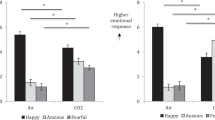Abstract
Acebutolol (400 mg once daily), atenolol (100 mg once daily) and placebo were self administered to 12 healthy male volunteers in a double-blind crossover study. Each drug treatment was administered for 4 days so that subjects' plasma levels of the drug were at steady state. Subjects were tested on the 4th day. On each of the 3 test days subjects underwent an anxiety induction procedure involving both easy and difficult versions of the Stroop test and syntactic reasoning. Measures of state anxiety were taken during the difficult task, an easy version of the task and after a period of quiet relaxation. High, medium and low levels of anxiety corresponded to the three levels of task difficulty. Highly significant differences were exhibited in state anxiety between high, medium and low anxiety induction procedures with both Stroop test and syntactic reasoning. This was shown by highly significant main effects for task difficulty with both tasks. There was no significant anxiolytic action of either acebutolol or atenolol when compared to placebo (there were no drug effects or any interaction of drugs with task difficulty). There were no significant drug effects upon any of the cognitive test measures. Overall, there was no evidence of either anxiolysis or sedation with either of these two relatively hydrophilic drugs.
Similar content being viewed by others
References
Baddeley AD (1968) A three minute reasoning test based on grammatical transformation. Psychon Sci 10:341–342
Baddeley AD, Hitch GJ (1974) Working memory. In: Bower G (ed) Recent advances in learning and motivation, vol 8. Academic Press, New York, pp 47–90
Betts T (1981) Effects of beta-blockade on driving. Aviat Space Environ Med 52:40–45
Brantigan TA, Brantigan CO, Joseph NH (1978) Beta-blockade and musical performance. Lancet, October 21, 896
Burrows B, Davies L, Fail, Poynton C, Stevenson H (1976) A plecebo controlled trial of diazepam and oxprenolol for anxiety. Psychopharmacology 50:177–179
Erdman G, Van Lindern B (1980) The effects of beta-adrenergic stimulation and beta-adrenergic blockade on emotional reactions. Psychophysiology 17:332–338
Farhoumand N, Harrison J, Pare CM, Turner P, Wynn S (1979) The effect of high dose oxprenolol on stress induced physical and psychophysical variables. Psychopharmacology 64:365–369
Flouvat B, Roux A, Chau NP, Viallet M, Andre-Fouet X, Woehrle R, Gregoire J (1981) Pharmacokinetics and bioavailability of diacetolol the main metabolite of acebutolol. Eur J Clin Pharmacol 19:227–292
Gibbons DO, Phillips M (1976) The effect of acebutolol on tachycardia and performance during competition rifle shooting. Br J Clin Pharmacol 3:516–517
Gottschalk LA, Stone WN, Glesser GC (1974) Peripheral versus central mechanism accounting for antianxiety effects of propranolol. Psychosom Med 36(1):47–56
Jensen AR, Rohwer WD (1965) The Stroop color-word test: a review. Acta Psychol 25:36–93
Johnson G, Singh B, Leeman M (1976) Controlled evaluation of the beta-adrenoceptor blocking drug oxprenolol in anxiety. Med J Aust 1:909–912
Krishnan G (1976) Oxprenolol in the treatment of examination stress. Curr Med Res Opin 4:241–243
Landauer AA, Pocock DA, Prott FW (1979) Effects of atenolol and propranolol on human performance and subjective feelings. Psychopharmacology 60:221–215
Lebrec D, Flouvat B, Decourt S, Dupont C (1983) Atenolol and liver function. Drugs 25:147
Lewis MJ, Jones DM, Dart AM, Henderson AH (1984) The psychological side effects of acebutolol and atenolol. Br J Clin Pharmacol 17:364–366
Liden S, Gottfies CG (1974) Beta-blocking agents in the treatment of catecholamine induced symptoms in musicians. Lancet, August 31:529
Meffin PJ, Winkle RA, Peters FA, Harrison DC (1977) Acebutolol disposition after intravenous administration. Clin Pharmacol Ther 22:557–567
Nordenfelt O (1965) Orthostatic ECG changes and the adrenergic beta-receptor blocking agent, propranolol (Inderal). Acta Med Scand 178:393–401
Ritschel WA (1982) Handbook of basic pharmacokinetics. Drug Intelligence Publications, Hamilton Press, Illinois, USA
Spielberger CD, Gorsuch RL, Lushene RE (1970) The state-trait anxiety inventory (STAI). Manual. Consulting Psychologists Press, California
Stroop JR (1935) Studies of interference in serial reactions. J Exp Psychol 18:643–662
Suzman MM (1971) The use of beta-adrenergic blockade with propranolol in anxiety syndromes. Postgrad Med J 47:104–108
Taggart P, Carruthers M (1972) Suppression by oxprenolol of adrenergic response to stress. Lancet II:256–258
Taggart P, Carruthers M, Somerville W (1973) Electrocardiogram, plasma catecholamines and lipids, and their modification by oxprenolol when speaking before and audience. Lancet II:341–346
Turner P, Granville-Grossman KL, Smart JV (1965) Effects of adrenergic receptor blockade on the tachycardia of thyrotoxicosis and anxiety state. Lancet December 25:1316–1318
Tyrer PJ, Lader MH (1974a) Response to propranolol and diazepam in somatic and psychic anxiety. Br Med J 2:14–16
Tyrer PJ, Lader MH (1974b) Physiological and psychological effects of ± propranolol and + propranolol and diazepam in induced anxiety. Br J Clin Pharmacol 1:379–385
Wheatley D (1969) Comparitive effects of propranolol and chlordiazepoxide in anxiety states. Br J Psychiatry 115:1411–1412
Author information
Authors and Affiliations
Rights and permissions
About this article
Cite this article
Kilminster, S.G., Lewis, M.J. & Jones, D.M. Anxiolytic effects of acebutolol and atenolol in healthy volunteers with induced anxiety. Psychopharmacology 95, 245–249 (1988). https://doi.org/10.1007/BF00174517
Received:
Revised:
Issue Date:
DOI: https://doi.org/10.1007/BF00174517




